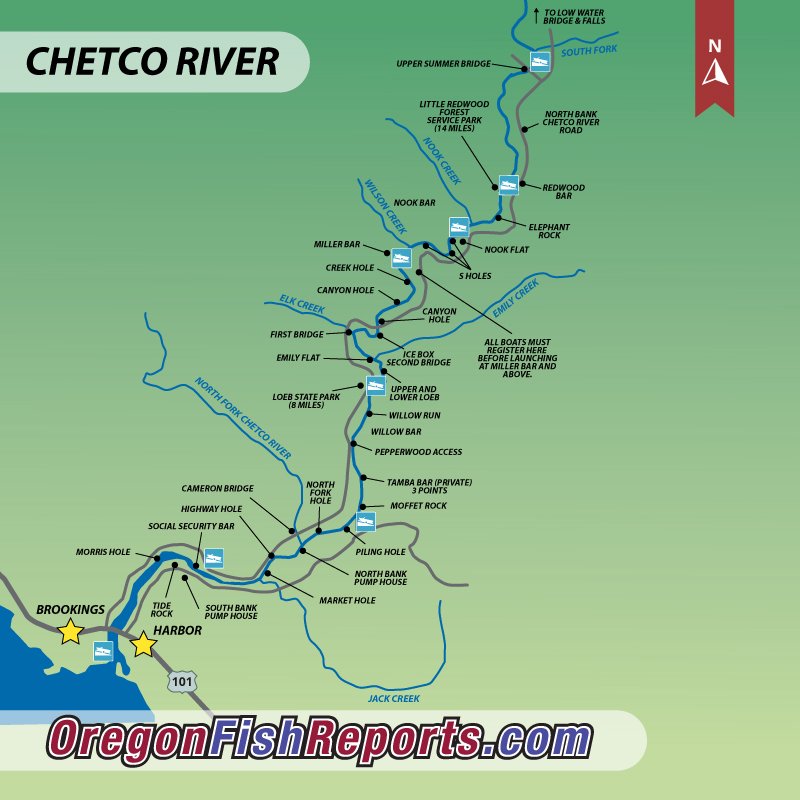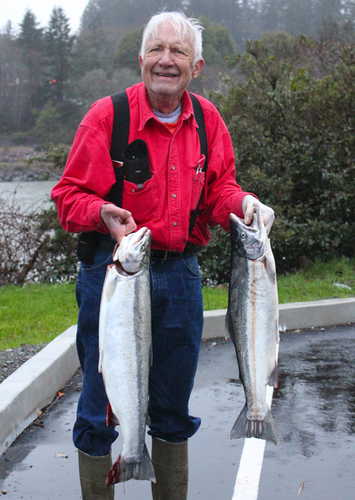Chetco River Fish Report for 1-28-2016
Will the Chetco ever side-drift this season?
Chetco River - Brookings, OR (Curry County)

by Larry Ellis
1-28-2016
Website
The Chetco River peaked last week at 10,500 cubic feet per second on Saturday, and anglers were hoping that it would stop rising and be experiencing an on-the-drop scenario for the rest of the week. That particular situation did occur and anglers were able to score some very nice hatchery and wild steelhead all throughout the river from Monday through Wednesday.
The river remained over 4,000 cfs through Wednesday, which put made for a perfect plunking situation, and by late Wednesday after the sun went down, the Chetco started dropping below 4,000 cfs, which meant that on Thursday, drift boat anglers were able to put in on the Chetco while it was at the upper 3,800 cfs flow mark and do a little side-drifting.
Steelhead were caught with abandon mostly by anglers plunking from the bank and a few fish were caught on Thursday by a few drift boat fishermen. But by Thursday the Chetco was already starting to experience an on-the-rise scenario and as everyone knows, steelhead do not bite the best on a rising river.
On Thursday Morning, the National Weather Service’s Advanced Hydrological Prediction Service was predicting that the Chetco would again rise sharply to 10,000 cfs and was expected to continue rising to 24,000 cubic feet per second on Friday. If that scenario occurs, the Chetco will surely blow out on Friday.
But this weekend the rains are expected to abate and the Chetco is expected to drop slowly but steadily and if that prediction comes to fruition, plunking will be the technique that dominates the reality of the Chetco River for at least 3 days from Sunday through Tuesday.
With showers diminishing at the first part of the week, the Chetco just might come into its first drift boating techniques by the middle of the week. It will all depend on the height of the river and the clarity of the water. So keep your eyes peeled to the Chetco’s gauge which can be found at rivervilla.com. If the river is steadily on-the-drop and goes below 4,000 cfs, it’s time to start side-drifting for steelhead.
Side-drifting without a doubt is the most effective technique for catching steelhead on the Chetco when the river drops below 4,000 cfs. Here is how it’s done.
When side-drifting, it is absolutely important that all anglers on board the boat have the same size rods, line and exact types of gear. When guides side-drift rivers, they always will have the exact same rod size, reel size, line size and weight size. Having rods, reels and tackle all the same enables the baits to all flow down the river at exactly the same speed, making it easier for guides and fishermen to be able to detect the strikes. This procedure enables all the gear to be concentrated in approximately the same area, making the guide’s watchful eye and the strikes more obvious.
Most of the time, anglers will be using rods between 7-1/2- to 8-feet long, and they will be using spinning reels for their main reels.
Rigging up is a breeze. Load up your reels with the same diameter monofilament or braid line. It doesn’t matter whether you use mono or braid, what matters is that all the rods on board are using mono or braid.
As a rule, I like to side-drift using 12-pound monofilament.
From the end of your mainline, thread the eye of a small snap swivel through the mainline and then tie the mainline to a number 7 barrel swivel.
In the snaps of the snap swivels you will be using either rubber tubing to house pencil lead, or you will be using slinkies. Whether you use pencil lead or slinkies is of no consequence, but on occasion, anglers will also be snapping on a Bouncing Betty or a Plunk-N-Dunk sinker.
For your leaders, you will be tying 3- to 4-foot pieces of monofilament to the ends of your number 7 barrel swivels.
On the ends of your leaders, most anglers will tie on a size 4 Gamakatsu octopus-style hook using an egg loop knot.
Using fresh roe really pays off in this type of fishery. You don’t have to use large piece of roe, only pinky-fingernail size pieces of roe. After you have put roe through your hooks and have wrapped your egg loop around the roe cluster, it is time to push up a small Puff Ball through the hook and up into the egg cluster which helps keep the hook bouncing off the bottom with a little buoyancy.
I also like to follow up the Puff Ball with a bait button, which helps keep the cluster of eggs and the Puff Ball in one nice neat unit. Bait buttons can be found at most sporting goods stores.
At the command of the oarsman, anglers will cast to a specific current seam, one angler followed by another. This keeps all the baits confined to one area and makes the job of the oarsman spotting bites a lot easier.
The oarsman then uses his or her drift boat like a fishing rod, and drifts down the current in a controlled situation, always keeping his anglers’ baits within eyesight.
If your Puff Ball-and-roe combos should suddenly stop drifting without warning, set the hook like you mean business, and set it fast – that’s probably a steelhead.
If the Chetco drops below 4,000 cfs, expect side-drifting to be the technique that rules the river this week. If the Chetco maintains a flow above 4,000 cfs, the plunkers with Spin-N-Glos in hand will again have the entire river to themselves. Either way, with the fishing as good as it has been, catching winter steelhead is a win-win situation for either plunkers or side-drifters.
Tight lines!
Larry Ellis, author, writer, columnist and photographer has had a 50-year passion for fishing in California and Oregon's saltwater and freshwater venues. He is a well-known writer for Oregon, Washington and California Fishing and Hunting News, Northwest Sportsman, California Sportsman and Pacific Coast Sportfishing. He currently writes monthly for Salmon Trout Steelheader Magazine, and is the author of two books, "Plug Fishing for Salmon" and "Buoy 10, the World's Largest Salmon Run." Both books can be bought from Amato Publications (amatobooks.com), Amazon and eBay. Ellis particularly loves living in his hometown of Brookings, Oregon - The heart of salmon country and gateway to fishing paradise.
More Reports
Plunkers Rule the Chetco
Chetco River
1-15-2016
Last week Mother Nature provided steelhead anglers the opportunity to deploy several fishing techniques. From Saturday through Monday, the...... Read More

Website Hosting and Design provided by TECK.net